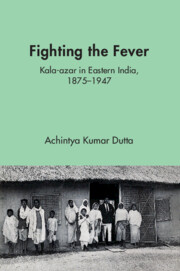Book contents
- Frontmatter
- Dedication
- Contents
- List of Figures
- List of Maps
- List of Tables
- Preface and Acknowledgements
- Note on Permissions
- List of Abbreviations
- Introduction
- 1 Kala-azar: A Disease Sui Generis
- 2 Medical Intervention and Containment of Epidemics
- 3 Agony of Assam: Defeating the Dreadful Kala-azar
- 4 Bengal’s Black Fever Burden: Beating the Disease
- 5 ‘Black Sigh’ in Bihar: Experiences and Responses
- 6 From Tartar Emetic to Urea Stibamine: Medical Research on Kala-azar and Its Fruition
- 7 The Unsung Hero: The Genius of Upendra Nath Brahmachari
- Conclusion
- Appendix: Number of Kala-azar Patients Admitted for Treatment in Bengal
- Bibliography
- Index
1 - Kala-azar: A Disease Sui Generis
Published online by Cambridge University Press: 13 February 2025
- Frontmatter
- Dedication
- Contents
- List of Figures
- List of Maps
- List of Tables
- Preface and Acknowledgements
- Note on Permissions
- List of Abbreviations
- Introduction
- 1 Kala-azar: A Disease Sui Generis
- 2 Medical Intervention and Containment of Epidemics
- 3 Agony of Assam: Defeating the Dreadful Kala-azar
- 4 Bengal’s Black Fever Burden: Beating the Disease
- 5 ‘Black Sigh’ in Bihar: Experiences and Responses
- 6 From Tartar Emetic to Urea Stibamine: Medical Research on Kala-azar and Its Fruition
- 7 The Unsung Hero: The Genius of Upendra Nath Brahmachari
- Conclusion
- Appendix: Number of Kala-azar Patients Admitted for Treatment in Bengal
- Bibliography
- Index
Summary
I may say at once that the appearance of the kala-jwar cases was in every respect similar to that of the more advanced cases of paludism; in fact, it was impossible to determine how the people themselves drew a distinction.
Kala-azar is a disease due to a general or systemic infection by a member of the leishmania group of parasites, which give[s] rise to various affections included under the general name of leishmaniasis. It occurs in children and adults and is characterized by high mortality in cases not treated with antimony, irregular fever, frequently running a chronic course, sometimes acute or subacute, and lasting from a few months to two or three years, or rarely more.
Black fever, also known as visceral leishmaniasis, or kala-azar in India, had been a serious health issue in British India for a century, threatening a large part of the Indian subcontinent in the nineteenth and twentieth centuries. There were several names for it, including Dumdum fever, kala-hazar, Assam fever, black sickness, and others. The Garos described it as sarkari bemari, or ‘saheb's disease’, referring to it as a British government illness not because any Europeans had it but rather because the Garos claimed to have been unaware of it until after the sahebs (referring to the British) took over their domain. This would seem to show that following the establishment of British control, outsiders brought the disease vector to the area. In Bengal, it was referred to as kala-jwar, which means ‘black fever’ or ‘fatal fever’, while it was known in Bihar as kala-dukh, which means ‘black suffering’ or ‘fatal misery’. With a high fatality rate of more than 95 per cent, kala-azar seemed to be an uncommon but deadly disease. It began spreading so quickly in the 1870s that the British government felt compelled to attempt to control it through medical intervention, but the results of such intervention were not seen until the 1920s. From 1921 onward, kala-azar mortality significantly decreased, and modern clinical medicine significantly contributed to this reduction.
Given that the disease was one of the leading causes of death in eastern India under British control, there is no dispute about its terrible impact. Despite being a neglected illness, it has recently been mentioned extensively in the press due to its comeback to epidemic proportions in north Bihar in 1976–1977.
- Type
- Chapter
- Information
- Fighting the FeverKala-azar in Eastern India, 1870s–1940s, pp. 17 - 65Publisher: Cambridge University PressPrint publication year: 2025

